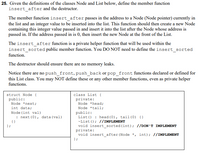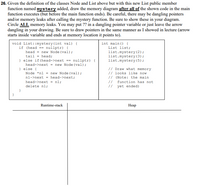
Computer Networking: A Top-Down Approach (7th Edition)
7th Edition
ISBN: 9780133594140
Author: James Kurose, Keith Ross
Publisher: PEARSON
expand_more
expand_more
format_list_bulleted
Question
Please answer and give an explanation for both questions in the images.

Transcribed Image Text:25. Given the definitions of the classes Node and List below, define the member function
insert_after and the destructor.
The member function insert_after passes in the address to a Node (Node pointer) currently in
the list and an integer value to be inserted into the list. This function should then create a new Node
containing this integer value passed in and insert it into the list after the Node whose address is
passed in. If the address passed in is 0, then insert the new Node at the front of the List.
The insert_after function is a private helper function that will be used within the
insert_sorted public member function. You DO NOT need to define the insert_sorted
function.
The destructor should ensure there are no memory leaks.
Notice there are no push_front, push_back or pop_front functions declared or defined for
this List class. You may NOT define these or any other member functions, even as private helper
functions.
struct Node {
public:
class List {
private:
Node *next;
Node *head;
int data;
Node (int val)
: next (0), data (val)
Node *tail;
public:
List () : head (0), tail (0) {}
-List (); //IMPLEMENT
void insert sorted (int); //DON'T IMPLEMENT
private:
void insert_after (Node *, int); //IMPLEMENT
{}
} ;
} ;

Transcribed Image Text:26. Given the definition of the classes Node and List above but with this new List public member
function named mystery added, draw the memory diagram after all of the shown code in the main
function executes (but before the main function ends). Be careful, there may be dangling pointers
and/or memory leaks after calling the mystery function. Be sure to show these in your diagram.
Circle ALL memory leaks. You may put ?? in a dangling pointer variable or just leave the arrow
dangling in your drawing. Be sure to draw pointers in the same manner as I showed in lecture (arrow
starts inside variable and ends at memory location it points to).
void List::mystery (int val) {
if (head == nullptr) {
head = new Node (val);
int main () {
List list;
list.mystery (2);
list.mystery (3);
list.mystery (5);
tail - head;
} else if (head->next == nullptr) {
head->next = new Node (val);
} else {
Node *nl = new Node (val);
// Draw what memory
// looks like now
// (Note: the main
//
nl->next = head->next;
head->next = nl;
function has not
delete nl;
// yet ended)
}
Runtime-stack
Heap
Expert Solution
This question has been solved!
Explore an expertly crafted, step-by-step solution for a thorough understanding of key concepts.
This is a popular solution
Trending nowThis is a popular solution!
Step by stepSolved in 3 steps with 2 images

Knowledge Booster
Similar questions
- Please answer the question in the image with reason/detail. Thank youarrow_forwardThe manoeuvre The vertical and slow-move-vertical methods are the ones that need to be practised initially. To move the circle to a place that is 70 pixels to the left of where it is now located in your document, use the moveHorizontal command.arrow_forwardFirst Column: Merge column 1, column 2 and column 3. Set the background color as "blue" and align the contents to the right. Insert a Search Form. Insert a suitable input type to select items like SUBJECTS, COURSES, CV HELP and JOB MARKET. Set any name for the form field. Insert a suitable input type to enter the search text. Set any name for the text field and the maximum length is 40. Insert a submit button with a value SEARCH COURSES. • Set a form validation using JAVASCRIPT. If the form field (search) is empty. display an alert message and return false to prevent the form from being submitted.arrow_forward
- The Koch snowflake is a fractal shape. At level 0, the shape is an equilateral triangle. At level 1, each line segment is split into four equal parts, producing an equilateral bump in the middle of each segment. Figure 7-15 shows these shapes at levels 0, 1, and 2. Figure 7-15 First three levels of a Koch snowflake At the top level, the script uses a function drawFractalLine to draw three fractal lines. Each line is specified by a given distance, direction (angle), and level: The initial angles are 0, -120, and 120 degrees. The initial distance can be any size, such as 200 pixels. If the level is 0, then t Python GUI TestIncomplete Program generates the correct imagearrow_forwardExplain how each of the three wrap attribute values of text areas work. View keyboard shortcutsarrow_forwardAnswer all of the following with True or False.arrow_forward
- Create a Website registration form to obtain a user’s first name, last name, email address. Also ask the user a question about the user’s year in college with radio button options.arrow_forwardPlease view attachment before answering. The attachment is the table and its contents. I am in need of assistance with both parts, A and B. I am unsure on how i can go about attempting the question. I am using mysql terminal. Please explain solution in detail so i can fully understand . Attaching a visual will be of great help as well. (as in a screenshot or so) Thank you so much in advance! Part A - Display the first name and the first 3 characters of the employee's first name from the employee table. Part B - Display the first name of employees which contain occurrences of 'a' and 'i' in the same name.arrow_forward
arrow_back_ios
arrow_forward_ios
Recommended textbooks for you
 Computer Networking: A Top-Down Approach (7th Edi...Computer EngineeringISBN:9780133594140Author:James Kurose, Keith RossPublisher:PEARSON
Computer Networking: A Top-Down Approach (7th Edi...Computer EngineeringISBN:9780133594140Author:James Kurose, Keith RossPublisher:PEARSON Computer Organization and Design MIPS Edition, Fi...Computer EngineeringISBN:9780124077263Author:David A. Patterson, John L. HennessyPublisher:Elsevier Science
Computer Organization and Design MIPS Edition, Fi...Computer EngineeringISBN:9780124077263Author:David A. Patterson, John L. HennessyPublisher:Elsevier Science Network+ Guide to Networks (MindTap Course List)Computer EngineeringISBN:9781337569330Author:Jill West, Tamara Dean, Jean AndrewsPublisher:Cengage Learning
Network+ Guide to Networks (MindTap Course List)Computer EngineeringISBN:9781337569330Author:Jill West, Tamara Dean, Jean AndrewsPublisher:Cengage Learning Concepts of Database ManagementComputer EngineeringISBN:9781337093422Author:Joy L. Starks, Philip J. Pratt, Mary Z. LastPublisher:Cengage Learning
Concepts of Database ManagementComputer EngineeringISBN:9781337093422Author:Joy L. Starks, Philip J. Pratt, Mary Z. LastPublisher:Cengage Learning Prelude to ProgrammingComputer EngineeringISBN:9780133750423Author:VENIT, StewartPublisher:Pearson Education
Prelude to ProgrammingComputer EngineeringISBN:9780133750423Author:VENIT, StewartPublisher:Pearson Education Sc Business Data Communications and Networking, T...Computer EngineeringISBN:9781119368830Author:FITZGERALDPublisher:WILEY
Sc Business Data Communications and Networking, T...Computer EngineeringISBN:9781119368830Author:FITZGERALDPublisher:WILEY

Computer Networking: A Top-Down Approach (7th Edi...
Computer Engineering
ISBN:9780133594140
Author:James Kurose, Keith Ross
Publisher:PEARSON

Computer Organization and Design MIPS Edition, Fi...
Computer Engineering
ISBN:9780124077263
Author:David A. Patterson, John L. Hennessy
Publisher:Elsevier Science

Network+ Guide to Networks (MindTap Course List)
Computer Engineering
ISBN:9781337569330
Author:Jill West, Tamara Dean, Jean Andrews
Publisher:Cengage Learning

Concepts of Database Management
Computer Engineering
ISBN:9781337093422
Author:Joy L. Starks, Philip J. Pratt, Mary Z. Last
Publisher:Cengage Learning

Prelude to Programming
Computer Engineering
ISBN:9780133750423
Author:VENIT, Stewart
Publisher:Pearson Education

Sc Business Data Communications and Networking, T...
Computer Engineering
ISBN:9781119368830
Author:FITZGERALD
Publisher:WILEY